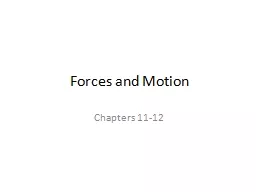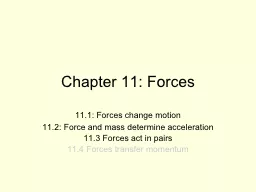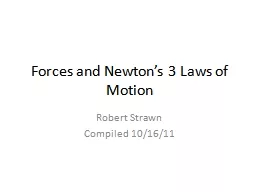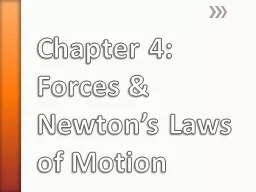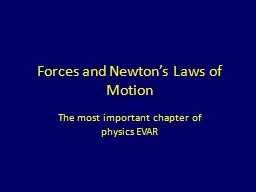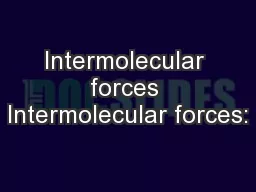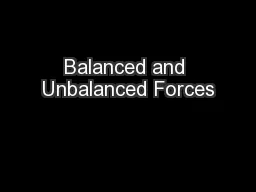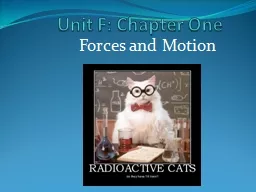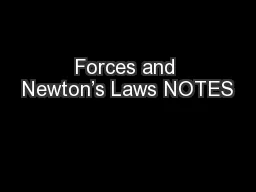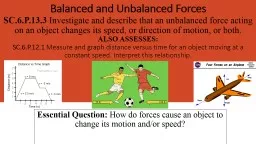PPT-Forces and Motion Chapters 11-12
Author : tatiana-dople | Published Date : 2019-11-19
Forces and Motion Chapters 1112 Frame of reference A system of objects that are not moving with respect to one another To describe motion accurately and completely
Presentation Embed Code
Download Presentation
Download Presentation The PPT/PDF document "Forces and Motion Chapters 11-12" is the property of its rightful owner. Permission is granted to download and print the materials on this website for personal, non-commercial use only, and to display it on your personal computer provided you do not modify the materials and that you retain all copyright notices contained in the materials. By downloading content from our website, you accept the terms of this agreement.
Forces and Motion Chapters 11-12: Transcript
Forces and Motion Chapters 1112 Frame of reference A system of objects that are not moving with respect to one another To describe motion accurately and completely a frame of reference is necessary. Here’s Tim & Mobey on Force. Brainpop. Suppose I asked you to move a heavy desk in the classroom. How would you move it? . hmmmmmmmmmmm...... You might get on one side of the desk and start pushing, Or you might grab the legs and start pulling. . 11.1: Forces change motion. 11.2: Force and mass determine acceleration. 11.3 Forces act in pairs. 11.4 Forces transfer momentum. Warm-up Questions (T or F). Speed includes direction, while velocity does not. Robert Strawn. Compiled 10/16/11. A force is any push or pull that one object exerts on . another that causes a change in motion, direction, or shape.. The unit for force is the Newton (N) and is equal to . Forces. Forces can be thought of as pushes and pulls. Examples. You exert a force on a door to open it (a push). Gravity exerts a force on you which holds you to the surface of the earth (a pull). Forces. The most important chapter of physics EVAR. What is a Force?. A force is a push or a pull. Contact forces:. Boat pulling a water skier. Pushing a car with a dead battery. Noncontact forces:. Gravitational attraction of moon to earth. the forces between (among) individual particles (atoms, ions, molecules); they are weak relative to . intramolecular. forces (i.e. covalent and ionic bonds within a compound). Intermolecular forces are increasingly significant in this order:. How do balanced and unbalanced forces affect an object's motion? . Inertia. is the resistance of any physical object to any change in its state of motion, including changes to its speed and direction. . By Matt Mosley, Britt . Boler. , and Park Gibbs. . http://www.youtube.com/watch?v=-eSN8Cwit_s. Summary of Chapter. Chapter 1: The first chapter is very short but it sets the setting for the novel, it takes place in Boston of the seventeenth century in June. It starts with a group of people standing outside of a prison door that Hawthorne describes in excessive detail about how dark it is. The door is an old wooden beat up door with weeds and a wild rosebush which makes the prison seem very dark.. What is a force?. A force is a push or a pull. . Forces make objects accelerate. What are the two general types of forces? How are they different?. Type 1: Contact Forces. Force as a result of object touching. Science Question of the Day . What causes the noise when you crack your joints?. _________________________________. _________________________________. _________________________________. Gravity . Gravity is a specific kind of _____________.. Force. - a . push. or . pull . A . Force . 1. gives. . energy . to objects. 2. causes a. . change . in motion, such as:. . Starting. Speeding Up. Changing Direction. Stopping. Slowing Down. (Note: all of these are forms of . Balanced and Unbalanced Forces SC.6.P.13.3 Investigate and describe that an unbalanced force acting on an object changes its speed, or direction of motion, or both. ALSO ASSESSES: SC.6.P.12.1 Measure and graph distance versus time for an object moving at a constant speed. Interpret this relationship. Dynamics I Forces & Newton’s First Law 4 Natural Forces Gravity : acts between all masses in the universe and has “infinite” range Electromagnetic (EM) Force : acts between electrically charged particles and “magnetically charged” poles The Covenant sets out the relationship between the nation, the government and the Armed Forces. It recognises that the whole nation has a moral obligation to members of the Armed Forces and their families, and it establishes how they should expect to be treated. .
Download Document
Here is the link to download the presentation.
"Forces and Motion Chapters 11-12"The content belongs to its owner. You may download and print it for personal use, without modification, and keep all copyright notices. By downloading, you agree to these terms.
Related Documents

